Page 158 of 474
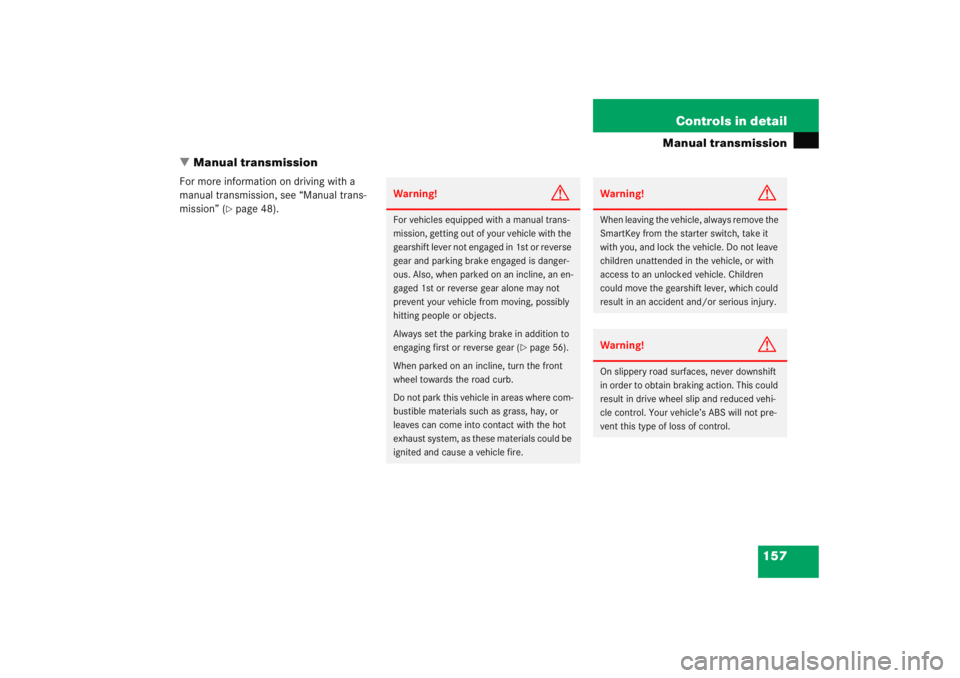
157
Controls in detail
Manual transmission
� Manual transmission
For more information on driving with a
manual transmission, see “Manual trans-
mission” (
�page 48).
Warning!
G
For vehicles equipped with a manual trans-
mission, getting out of your vehicle with the
gearshift lever not engaged in 1st or reverse
gear and parking brake engaged is danger-
ous. Also, when parked on an incline, an en-
gaged 1st or reverse gear alone may not
prevent your vehicle from moving, possibly
hitting people or objects.
Always set the parking brake in addition to
engaging first or reverse gear (
�page 56).
When parked on an incline, turn the front
wheel towards the road curb.
Do not park this vehicle in areas where com-
bustible materials such as grass, hay, or
leaves can come into contact with the hot
exhaust system, as these materials could be
ignited and cause a vehicle fire.
Warning!
G
When leaving the vehicle, always remove the
SmartKey from the starter switch, take it
with you, and lock the vehicle. Do not leave
children unattended in the vehicle, or with
access to an unlocked vehicle. Children
could move the gearshift lever, which could
result in an accident and/or serious injury.Warning!
G
On slippery road surfaces, never downshift
in order to obtain braking action. This could
result in drive wheel slip and reduced vehi-
cle control. Your vehicle’s ABS will not pre-
vent this type of loss of control.
Page 160 of 474
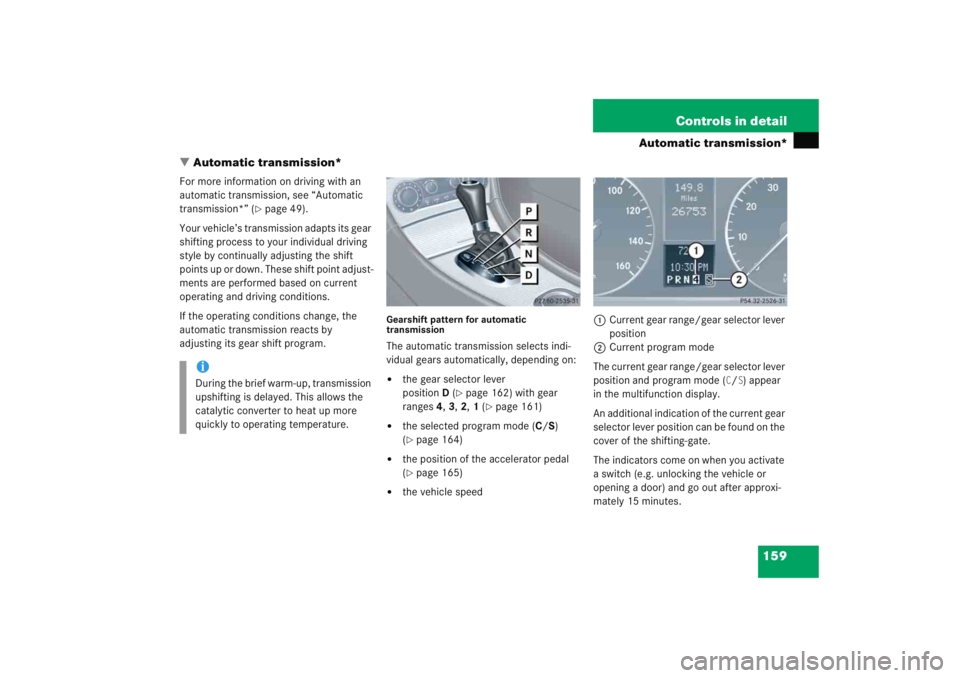
159
Controls in detail
Automatic transmission*
� Automatic transmission*
For more information on driving with an
automatic transmission, see “Automatic
transmission*” (
�page 49).
Your vehicle’s transmission adapts its gear
shifting process to your individual driving
style by continually adjusting the shift
points up or down. These shift point adjust-
ments are performed based on current
operating and driving conditions.
If the operating conditions change, the
automatic transmission reacts by
adjusting its gear shift program.
Gearshift pattern for automatic
transmissionThe automatic transmission selects indi-
vidual gears automatically, depending on:�
the gear selector lever
position D(
�page 162) with gear
ranges 4, 3 , 2 , 1 (
�page 161)
�
the selected program mode ( C/S)
(�page 164)
�
the position of the accelerator pedal
(�page 165)
�
the vehicle speed 1
Current gear range/gear selector lever
position
2 Current program mode
The current gear range/gear selector lever
position and program mode (
C/S) appear
in the multifunction display.
An additional indication of the current gear
selector lever position can be found on the
cover of the shifting-gate.
The indicators come on when you activate
a switch (e.g. unlocking the vehicle or
opening a door) and go out after approxi-
mately 15 minutes.
iDuring the brief warm-up, transmission
upshifting is delayed. This allows the
catalytic converter to heat up more
quickly to operating temperature.
Page 163 of 474
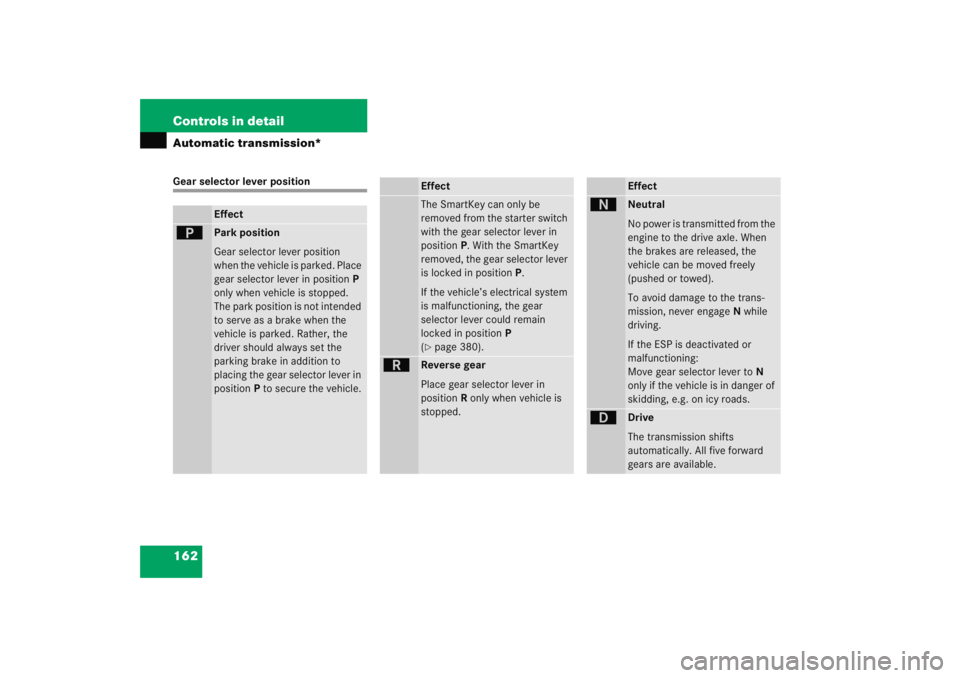
162 Controls in detailAutomatic transmission*Gear selector lever position
Effect
ì
Park position
Gear selector lever position
when the vehicle is parked. Place
gear selector lever in positionP
only when vehicle is stopped.
The park position is not intended
to serve as a brake when the
vehicle is parked. Rather, the
driver should always set the
parking brake in addition to
placing the gear selector lever in
position P to secure the vehicle.
EffectThe SmartKey can only be
removed from the starter switch
with the gear selector lever in
position P. With the SmartKey
removed, the gear selector lever
is locked in position P.
If the vehicle’s electrical system
is malfunctioning, the gear
selector lever could remain
locked in position P
(�page 380).
í
Reverse gear
Place gear selector lever in
position R only when vehicle is
stopped.
Effect
ë
Neutral
No power is transmitted from the
engine to the drive axle. When
the brakes are released, the
vehicle can be moved freely
(pushed or towed).
To avoid damage to the trans-
mission, never engage N while
driving.
If the ESP is deactivated or
malfunctioning:
Move gear selector lever to N
only if the vehicle is in danger of
skidding, e.g. on icy roads.
ê
Drive
The transmission shifts
automatically. All five forward
gears are available.
Page 164 of 474
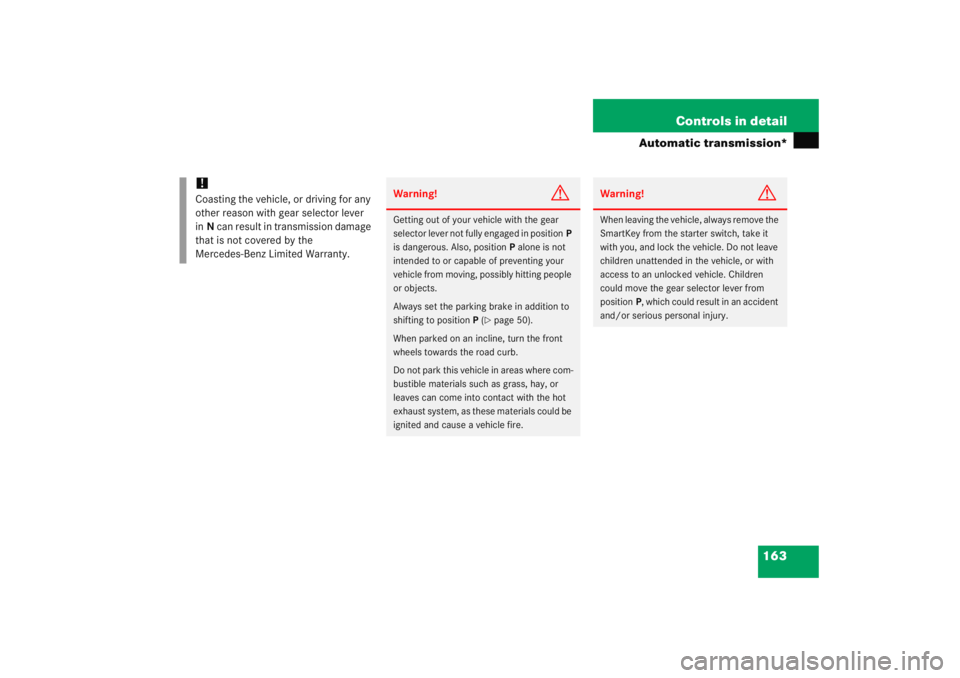
163
Controls in detail
Automatic transmission*
!
Coasting the vehicle, or driving for any
other reason with gear selector lever
in N can result in transmission damage
that is not covered by the
Mercedes-Benz Limited Warranty.
Warning!
G
Getting out of your vehicle with the gear
selector lever not fully engaged in position P
is dangerous. Also, position P alone is not
intended to or capable of preventing your
vehicle from moving, possibly hitting people
or objects.
Always set the parking brake in addition to
shifting to position P (
�page 50).
When parked on an incline, turn the front
wheels towards the road curb.
Do not park this vehicle in areas where com-
bustible materials such as grass, hay, or
leaves can come into contact with the hot
exhaust system, as these materials could be
ignited and cause a vehicle fire.
Warning!
G
When leaving the vehicle, always remove the
SmartKey from the starter switch, take it
with you, and lock the vehicle. Do not leave
children unattended in the vehicle, or with
access to an unlocked vehicle. Children
could move the gear selector lever from
position P, which could result in an accident
and/or serious personal injury.
Page 176 of 474

175
Controls in detail
Climate control
Deactivating the climate control system
Deactivating�
Set air volume control
1 (
�page 173)
to position 0.
Reactivating
�
Set air volume control 1 (
�page 173)
to any speed.
Setting the temperature
Use temperature controls 2 and 3
(�page 173) to separately adjust the air
temperature on each side of the passenger
compartment. You should raise or lower
the temperature setting in small incre-
ments, preferably starting at 72°F (22°C). Increasing
�
Turn temperature control
2 or 3
slightly to the right.
The climate control system will corre-
spondingly adjust the interior air tem-
perature.
Decreasing
�
Turn temperature control 2 or 3
slightly counterclockwise.
The climate control system will corre-
spondingly adjust the interior air tem-
perature.
iWhen the air conditioning is switched
off, the outside air supply and circula-
tion are also switched off. Only choose
this setting for a short time. Otherwise
the windows could fog up.
iWhen operating the climate control
system in automatic mode, you will
only rarely need to adjust the tempera-
ture, air volume and air distribution.
Page 229 of 474
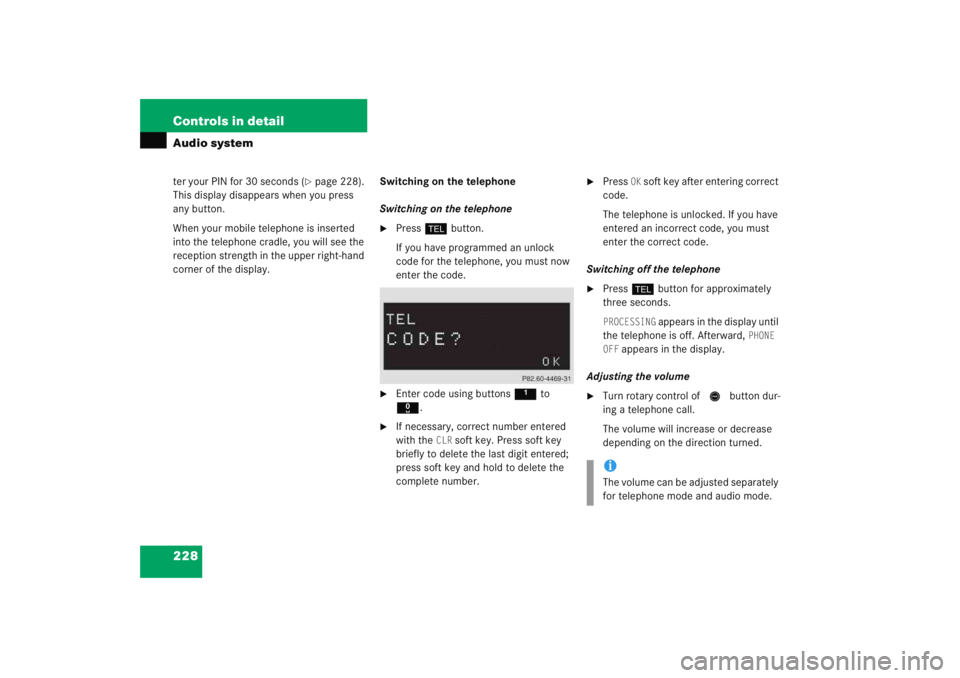
228 Controls in detailAudio systemter your PIN for 30 seconds (
�page 228).
This display disappears when you press
any button.
When your mobile telephone is inserted
into the telephone cradle, you will see the
reception strength in the upper right-hand
corner of the display. Switching on the telephone
Switching on the telephone
�
Press
h button.
If you have programmed an unlock
code for the telephone, you must now
enter the code.
�
Enter code using buttons 1 to
R .
�
If necessary, correct number entered
with the
CLR
soft key. Press soft key
briefly to delete the last digit entered;
press soft key and hold to delete the
complete number.
�
Press
OK soft key after entering correct
code.
The telephone is unlocked. If you have
entered an incorrect code, you must
enter the correct code.
Switching off the telephone
�
Press h button for approximately
three seconds.PROCESSING
appears in the display until
the telephone is off. Afterward,
PHONE
OFF
appears in the display.
Adjusting the volume
�
Turn rotary control of N button dur-
ing a telephone call.
The volume will increase or decrease
depending on the direction turned.iThe volume can be adjusted separately
for telephone mode and audio mode.
Page 236 of 474
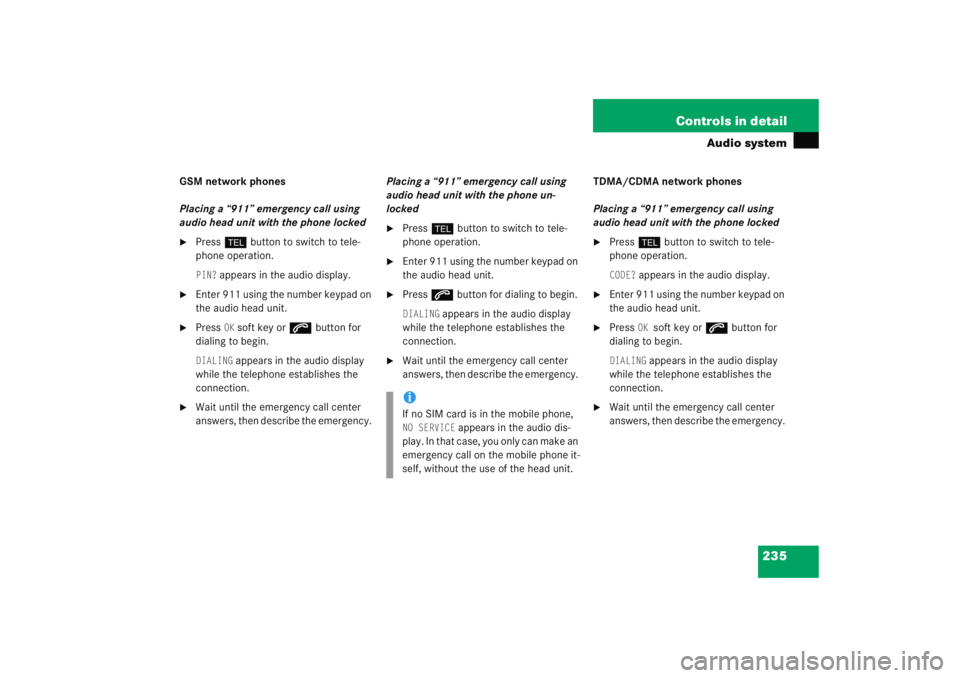
235
Controls in detail
Audio system
GSM network phones
Placing a “911” emergency call using
audio head unit with the phone locked�
Press
hbutton to switch to tele-
phone operation. PIN?
appears in the audio display.
�
Enter 911 using the number keypad on
the audio head unit.
�
Press
OK soft key or sbutton for
dialing to begin.
DIALING
appears in the audio display
while the telephone establishes the
connection.
�
Wait until the emergency call center
answers, then describe the emergency. Placing a “911” emergency call using
audio head unit with the phone un-
locked
�
Press
hbutton to switch to tele-
phone operation.
�
Enter 911 using the number keypad on
the audio head unit.
�
Press sbutton for dialing to begin. DIALING
appears in the audio display
while the telephone establishes the
connection.
�
Wait until the emergency call center
answers, then describe the emergency. TDMA/CDMA network phones
Placing a “911” emergency call using
audio head unit with the phone locked
�
Press
hbutton to switch to tele-
phone operation. CODE?
appears in the audio display.
�
Enter 911 using the number keypad on
the audio head unit.
�
Press
OK
soft key or sbutton for
dialing to begin.
DIALING
appears in the audio display
while the telephone establishes the
connection.
�
Wait until the emergency call center
answers, then describe the emergency.
iIf no SIM card is in the mobile phone, NO SERVICE
appears in the audio dis-
play. In that case, you only can make an
emergency call on the mobile phone it-
self, without the use of the head unit.
Page 237 of 474
236 Controls in detailAudio systemPlacing a “911” emergency call using
audio head unit with the phone un-
locked�
Press hbutton to switch to tele-
phone operation.
�
Enter 911 using the number keypad on
the audio head unit.
�
Press sbutton for dialing to begin.DIALING
appears in the audio display
while the telephone establishes the
connection.
�
Wait until the emergency call center
answers, then describe the emergency.